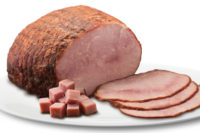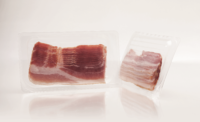Ham Innovation
By Sam Gazdziak, Senior Editor
It’s a holiday staple and a sandwich meat favorite.
But is the appeal for ham still as strong as ever?
Families have gathered around the table for years to enjoy a Christmas or Easter ham. As a “special occasion” entrée, a freshly carved ham is tough to beat. But what about the rest of the year? Ham is versatile enough to be sold as everything from a main course to lunch meat to pizza topping and more, and the industry’s leading ham processors are doing their part to keep ham as a top protein well into the future.
Hormel Corp., headquartered in Austin, Minn., created the first canned ham in 1926 and the first boneless ham in 1963. Kurt Lindsay, assistant product manager for Hormel Foods, says that the company has always strived to meet the consumer’s changing needs with new products, flavors and cooking options. “For instance, our research showed that consumers were afraid of drying out their ham when cooking it and wished that ham preparation was a little easier. So we introduced Hormel Cure 81® Oven Ready Bone In Spiral ham, which offers a more convenient way to prepare ham for the holiday meal,” he says. The ham is packaged in an oven-ready bag that includes a pre-mixed glaze, ensuring that the ham will be moist and juicy when taken out of the oven.
Ron Link, vice president of marketing for Kansas City-based Farmland Foods Inc., says that the company is very active in finding different meal occasions for ham in both the retail and the foodservice categories. He says the company has been looking into different forms and flavors to broaden the appeal of ham items to the consumer.
Hatfield Quality Meats has been in business for more than 100 years. Today, the company, headquartered in Hatfield, Pa., sells its products throughout the Northeast and Mid-Atlantic regions. After looking at consumer trends, Hatfield has developed products that make ham consumption easier for consumers looking for convenience, says Dennis Bower, business unit manager - Processed Meats. “We’ve developed products that save the consumer time and effort, such as pre-sliced, pre-cooked and pre-portioned,” he says. Additionally, as the family size has gotten smaller, the company has also developed smaller-sized whole hams to offer a more attractive dinnertime option. The company’s Country Made Boneless Ham is also available in half, quarter and whole sizes, and its ham steaks are sold in 16-ounce and 8-ounce sizes, in a number of different flavors.
Though the ham category may be a mature one, the top processors are still finding plenty of room for innovation. “With consumers looking for new and exciting taste experiences, we’ve developed items with unique flavor profiles, such as Applewood Flavored Ham,” Bower says. “In addition, to broaden the appeal outside of the traditional mealtime options, we’ve introduced items into the appetizer category.” Hatfield also has been introducing ham items into non-traditional areas of the grocery store, such at the salad bar and the hot foods case.
Lindsey says that Hormel has sought out ways to bring lapsed ham consumers back into the fold. “Our research shows that some consumers don’t shop the ham category because they perceive ham to be ‘too processed.’ We created the Hormel Natural Choice® ham, which is minimally processed and has no artificial ingredients or flavors and is made with no preservatives such as nitrates, nitrites or potassium lactates,” he says. The new ham comes in two flavors, Honey and Applewood Smoked.
Farmland has been working to develop unique ham products, such as grillable products that come with a wooden grilling plank, but it also gotten involved in the natural meats sector with the introduction of its Farmland Simply Natural and Farmland All Natural hams. “All-natural is a big trend that’s starting to take off, and we’ll have more focus on all-natural products,” Link says.
The All Natural hams are minimally processed without any extra additives, and the pork farmers follow a strict continual improvement process to earn the source-verified description that appears on each label. The Classic and Original hams in the line are whole-muscle, boneless hams that are naturally smoked with hickory wood. The Spiral Sliced is smoked and sliced to the bone and is wrapped in foil and netted.
Farmland Simply Natural ham products also have the source-verified description on the label, and its hogs are never given antibiotics and are given a vegetarian diet. The products also offer improved marbling and attractive and consistent ham coloring.
Higher-tech hams
As with anything in the fast-changing meat processing industry, developments in processing equipment and related technologies have continued to refine the end product. Link says that ham today has more flavor to it than it has in years past. “Making ham more tender has been a push for a lot of companies, [as well as] experimenting with a lot of different flavors and flavored smoke — a more robust honey flavor or brown sugar, flavors that enhance hams.”
Link says that science has helped produce a better raw product as well, such as ham with just the right amount of marbling to create a better flavor. “We’re seeing more and more developments on the genetic side of the business,” he says.
Hatfield has utilized new technology that helps improve the visual appeal of its hams. “By their nature, different parts of the ham muscle have varying degrees of color,” says Bower. “A new technology has been developed which imparts an even color tone to the ham. Hatfield Quality Meats has had great success with this new technology.”
Lindsey says that despite advances in production technology, much of Hormel’s processing is still done by hand, with the Cure 81 products being hand trimmed and naturally hardwood smoked. “Each ham is individually inspected, registered and guaranteed by our curemaster,” he notes. He does note that the ability to create natural products that can meet stringent food safety standards has been a big help for the company. “Consumers get a great-tasting product that’s better for them,” he says.
Looking into the future, Bower says that the ham sector will continue to stay strong, provided companies adapt to change. “Manufacturers of ham products must continue to innovate and offer consumers convenient meal solution options and products with greater taste,” he says.



Report Abusive Comment